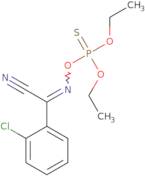Chlorphoxim
CAS: 14816-20-7
Ref. 3D-FC150951
| 1g | Descatalogado | ||
| 50mg | Descatalogado | ||
| 100mg | Descatalogado | ||
| 250mg | Descatalogado | ||
| 500mg | Descatalogado |
Información del producto
- (o-Chlorophenyl)glyoxylonitrile oxime O,O-diethyl phosphorothioate
- 14816-20-7
- 2-chloro-N-diethoxyphosphinothioyloxy-benzimidoyl cyanide
- 3,5-Dioxa-6-aza-4-phosphaoct-6-ene-8-nitrile, 7-(2-chlorophenyl)-4-ethoxy-, 4-sulfide
- Bay 78172
- Bay 78182
- Bayer 78182
- ENT 27449Ga
- Glyoxylonitrile, (o-chlorophenyl)-, oxime O,O-diethyl phosphorothioate
- O,O-Diethyl phosphorothioate O-ester with (o-(chlorophenyl)glyoxylonitrile oxime
- Ver más sinónimos
- Phosphorothioic acid, O-2-chloro-α-cyanobenzylideneamino O,O-diethyl ester
- Phosphorothioic acid, O-[[(2-chlorophenyl)cyanomethylene]azanyl] O,O-diethyl ester
Chlorphoxim is a broad spectrum insecticide that has been approved for use as a chemical pesticide. This product is used in cotton fields to control the spread of boll weevil, leaf beetle, and other pests. Chlorphoxim is applied as a liquid formulation or granules, which are then activated by rain or irrigation. The active ingredients are hexane, piperonyl butoxide, and carbaryl. Chlorphoxim is registered in tropical countries for agricultural use against insects that transmit disease to humans such as ticks and mosquitoes. In the United States, chlorpyrifos-methyl has replaced chlorphoxim for this application.





